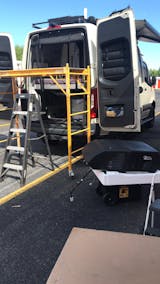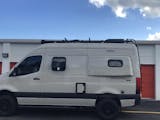Limited to 5000 characters here. Posted the full review with pictures and data on Sprinter Source. here is the link...
https://sprinter-source.com/forums/index.php?threads/125293/#post-1386355
AC + Solar install and test results
We use our van for trips where we might likely be off grid but would move the van (recharge via alternator) at least once every 2-3 days.
Our Sprinter 170 has an Adventure Wagon interior. All of the interior metal walls and ceilings have Hushmat Ultra foil backed dampening and then 3M Thinslate insulation on the floor, walls and ceiling. We have CRL windows behind the driver, on the sliding door and two smaller CRL windows in the rear, one on each side for ventilation by the bed. We installed 4 x 100aH of Battle Born batteries. We also went with a Victron 3000-watt inverter/charger - capable of converting 12v supply from the batteries for a 120v AC unit. The majority of the roof was free for solar panels. If we were going to add AC, we wanted an off-the-grid system (AC and Solar) which could, in a 24-hour cycle, generate enough solar power to replace the energy we consumed while the AC cooled the van to ~76 F while we slept.
Fast forward to 2023 and we decided to install air conditioning and solar into our Sprinter. The improvements and availability of 12v ACs and improvements and form factors for solar panels seemed to make off-the-grid AC (for sleeping) possible. Here’s a high-level overview of what we did.
We moved the MaxxAir fan from the back of the van to the front.
We then installed the 12v 8000 BTU AC unit from Velit in the 14” by 14” hole in the back of the Sprinter where the MaxxAir had been.
We also installed the solar system (Victron SmartSolar MPPT Charger + three Renogy 175-watt solar panels) with Rhino Rack front fairing added.
When we were looking at AC units, we were focused on efficiency, not only at full power but also at lower output levels. How many BTUs per watt could we get. The noise was also a consideration. The Velit AC uses a twin-rotor compressor which has good efficiency over a wide range while others use a scroll compressor which has similar efficiency at the high end but lower efficiency at lower RPMs.
Test 1&2: (cut out)
Test 3: 2 Cycles of Sleeping then Regen simulation: Simulating off-the-grid AC during the evening with the Sleeping Quarters curtained off then recharging with solar the next day.
When we started the project of adding AC, it was understood that our van’s layout could be utilized to optimize how much energy we used to cool our sleeping area. Our van has a queen bed elevated ~36” across the back of the van.
At 17:58 (about 6:00pm) started timed lapsed video. The Velit AC was started in Turbo or Boost mode – its highest output. An hour later it was turned to SLEEP mode. The sleeping area was kept at 75-76 all night. By 5:30am the next morning the AC was turned off with 45.6% of the battery remaining. One mistake I made was keeping the inverter powered which drew watts even though it was idle. I realized this an hour into the test and turned it off. (Data removed)
Lessons learned from Cycle 1 were applied to Cycle 2. Even though the van was quite hot from being closed, the AC cooled the sleeping quarters in 30-40 minutes. This meant that The AC could be turned on later in the evening, closer to sleeping time, thus saving some power. Due to an overcast day, the batteries recharged to 76% by 16:48 (~5pm) and actually reached 80.2% by the time the second cycle was started. You will notice that, overall, the first cycle ran net of draining the battery by 20%. Given the lessons learned from the first cycle, I was looking forward to the second cycle.
Cycle 2
Lessons learned from the second cycle. The Velit AC SLEEP mode is effective and efficient in cooling the sleeping area especially when it is dark (not fighting against the sun). The combination of mostly passive cooling the van and starting the AC later in the evening resulted in the system using 28.1% of the battery. The next day, the solar panels regenerated 39.1% of the battery. The net effect is a positive 11% of energy generated vs. consumed by the AC. If we ran the cycle for another day, the battery would be back up to 100%.
Conclusion
The above results give us confidence that we could stay stationary for three or more days and not have to worry about draining the batteries. In reality, we’ll be running other loads but those are quite small in comparison to the AC unit.
Overall, we are very pleased with this addition to our Sprinter. The system is effective at cooling the van and regenerating enough energy in a 24-hour cycle. The Velit AC was an easy install especially given it fits into the 14” x 14” hole that the MaxxAir previously occupied. It also seems to function as expected. The Velit AC and 175-watt Renogy panels are also a clean, low profile, no overhang installation on the roof. The Velit AC only rises 7” above the roof.












































